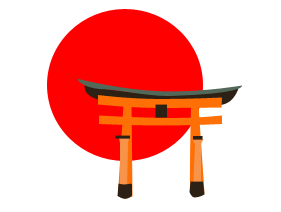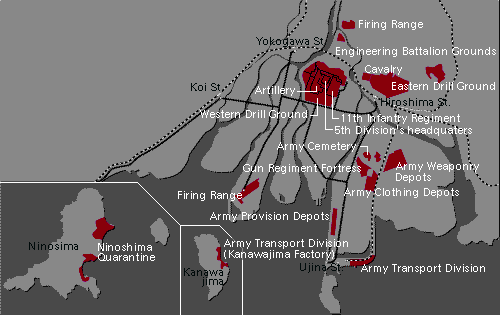
During the Edo period (1603-1867) Hiroshima was the principal castle town in the Chugoku-Shikoku region.
Following the Meiji Restoration of 1867 it took on a new identity as the seat of government of Hiroshima prefecture. Hiroshima at that time was a city of schools and shopping districts situated on a beautiful delta filled with towering trees and surrounded by the sea, rivers and mountains.
Gradually military facilities increased and Hiroshima became known for its dual role-center of education and military base.
In the 1920’s heavy industries began developing in Hiroshima, and by the end of the 1930’s, these were also being transformed into factories for military production.
By the time of the A-bombing, the Hiroshima Bay area, combined with the naval facilities in Kure, had taken on a strong military character.
++The Meiji and Taisho Period++
Riding the wave of modernization, Hiroshima gradually strengthened its military and educational functions. During the Sino-Japanese War (1894-1895), the Imperial Headquarters, the command center for the war, was established in the city, lending Ujina Harbor a distinctly military tone.
Each time Japan became involved in a military action in Asia, Hiroshima was the base for assembly and dispatching of troops. As years went by, Hiroshima’s military facilities grew more numerous and substantial.
On the other hand, the Hiroshima Branch of the School of High Education opened its doors in 1902. Along with other educational facilities, Hiroshima came to be known as an academic city.
++The Aioi Bridge++
The famous T-shaped Aioi Bridge was completed in October 1934. To make way for a new bridge, the older one forming a V shape at the north tip of the Nakajima district, was demolished. The T-shaped bridge is said to have been the target of the A-bomb.
Aioi Bridge before it was rebuilt in a T-shape. Courtesy of Hiroshima Municipal Archives
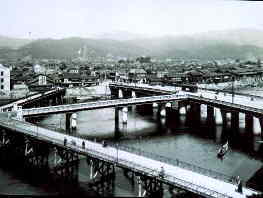
++The Sino-Japanese War and Ujina Harbor++
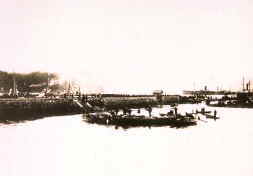
Ujina Harbor located at the south of the city was completed in 1889.
The Ujina Line, a military railway, was constructed soon after the onset of the Sino-Japanese War. Ujina became the departure point for troops heading off to the war in China. Later, along the Ujina Line the three depots for Army Ordnance Supply, Army Clothing and Army Provisions were established. The Army Transport Division, responsible for transport and supply of army goods, was stationed in Ujina, increasing its importance to the war effort.
Transport ships and small boats at Ujina Port used for carrying dispatched soldiers during Sino-Japanese War of 1894-1895. Courtesy of Japanese History Research Room, Faculty of Literature, .Hiroshima University
++Hiroshima in the Showa Period and During Wars++
In 1931, the Manchurian Incident led to the Japanese Army’s engagement in armed conflict in China.
By 1937, the incident had become a full-scale war between the two nations. In 1941, a surprise attack on the U.S. naval base at Pearl Harbor hurtled Japan into the Pacific War (World War II), allied with the Axis powers.
Following military orders, many Hiroshima factories shifted production from consumer to military goods. People’s lives grew increasingly austere, and many civilians were mobilized at the front or in military factories.
Among them were thousands of Koreans and Chinese forced to work for the Japanese.
++National Mobilization of Spirit++

In 1937, following the outbreak of the war in China, the Konoe administration adopted a new system that sought to mobilize the entire Japanese nation. This concept not only reached in to control the everyday lives of the Japanese, it also insisted on “spiritual mobilization,” denying even freedom of thought.
Citizens in Hiroshima were also forced to live austere lives under such slogans as “Waste is the enemy,” and “Doing without until victory.”
As daily commodities such as food, clothing, etc. became scarce, a rationing system started. People’s lives fell on hard times, depending on black markets or cultivating even school grounds for food production.
An air-raid shelter was built, and people were forced to exercise evacuation drill, or a bucket relay for extinguishing fire.
Military drill had been carried out at school since the Meiji period. In the Showa period an army man was attached to middle schools and the other higher schools to strengthen the drill.
National mobilization poster. Courtesy of Hiroshima Municipal Archives
++Student Labor Mobilization for Military Factories++
Following the Sino-Japanese War, with its military-related depots, Hiroshima gradually took on the atmosphere of a military supply base. In 1942, the Marine Headquarters (commonly known as the Akatsuki Corps) was established in the city. To supplement ongoing labor shortages, depots and military factories mobilized women and students as labor. It is said that by May 1944, about one quarter of the factory workers in the prefecture were mobilized students.
Students mobilized at the Hiroshima Army Ordnance Supply Depot. Courtesy of Hiroshi Yano
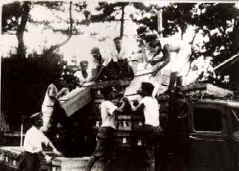
++Forced Labor Program for Ethnic Minorities++
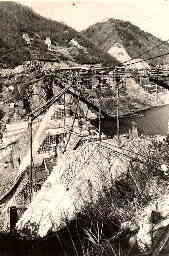
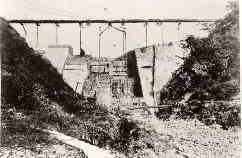
The National Mobilization Law of April 1938 led to an outright order to mobilize all available workers in July 1939. Workers in private corporations were forced to work in military factories, including Koreans and other ethnic minorities. Thousands of people throughout the prefecture were drafted to work at such locations as the electric power plant in northern Hiroshima Prefecture and military factories in the city. Many forced laborers survived extremely harsh working conditions only to die in the atomic bombing.
Kobo Dam in Takano-cho, Hiba-gun, under construction by forced labor of Koreans and others (1943). Courtesy of Miyoshi District History Research Organization.
++Forced Demolition of Homes++
In March 1943, the national government adopted the Urban Demolition Plan that targeted 133 locations in Hiroshima for destruction. To protect against fires resulting from air raids, residents living near such key facilities as public offices and agencies, military facilities and military factories were forcibly evicted from their homes. Their homes and other buildings were demolished to create fire lanes. Students, civilians, and residents of nearby towns and villages were mobilized for the demolition work. They were outside, engaged in that work, on the day of the A-bombing; most were killed or injured.
Working on demolished buildings
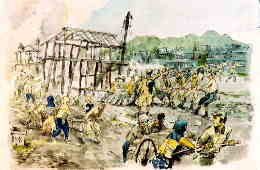
++Evacuating Pupils++
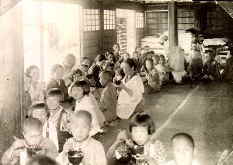
For their protection, school children were evacuated from major cities. Hiroshima City implemented evacuation in March 1945. Two types of evacuation were allowed. Large groups were evacuated to rural temples and shrines, but individuals or families could also request to be taken to the homes of friends or relatives. The homes for which these individuals were bound suffered like the rest of Japan from acute food shortages, so many of the young evacuees suffered great hardships.
Evacuated children visiting perents at the Noboricho National Elementary
Evacuated children visiting perents at the Noboricho National Elementary School Courtecy of Haruko Yokoue
